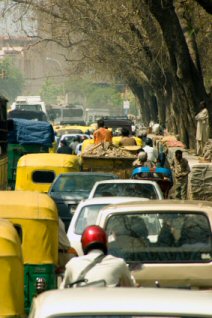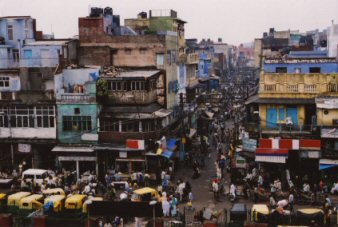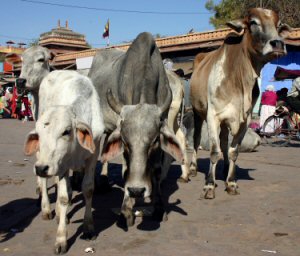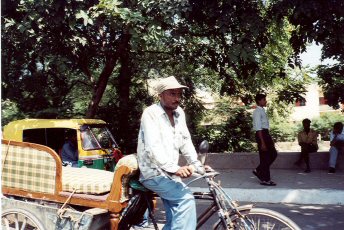Paint a Picture of Road Traffic Safety in India

Note: Road traffic safety is part of a travel blog that I wrote during an extended business trip to India. I spent two months in New Delhi as my employer implemented a new business unit in two of its call centers. In addition to my professional work, I took time to study Hindi, an effort that fostered greater co-operation and trust among my Indian business associates. It also helped me better understand the culture. We believe that language opens a gateway to understanding culture. These pages focus on my observations and experiences in India. While I was there, I practiced Walkabout Language Learning. See the list of "More India Stories" on this page to explore how culture and language intertwine.
 This picture give a glimpse of the gridlock driving conditions in Delhi.
This picture give a glimpse of the gridlock driving conditions in Delhi. iStockphoto
Let's see if I can paint a picture of traffic here in India. It is so picturesque that I'm not sure if I will be able to do it justice in a verbal picture, but we'll see. First off, you must turn your thinking completely upside-down because they drive on the left hand side of the road. So begin to imagine driving in a mirror image. While that image settles, consider these elements of the picture: the passenger side is on the left hand side of the car (if you are sitting in the car).
Imagine the disconcerting feeling as you drive past a car and you look into the car you are passing, the right front seat--the one that is normally the driver's seat--is empty. It gives you the uncomfortable feeling that you are driving around with a bunch of driverless cars. Add to this the confusing notion that the fast "lane" is on the right hand side of the road and the slower traffic moves on the left. Let that image settle a little in your mind ... For people in the UK, New Zealand, Australia and other places, this will seem quite comfortable, but not for the rest of us ...
Now, clear the slate and let's take up an entirely different picture. Imagine yourself a pedestrian on a busy New York sidewalk during rush hour. Picture the disorganized movement down the block as people jostle forward, pressing upon each other while they wait for stop lights, weaving in and out and around slower walkers as they move forward. Personal space diminishes to a small bubble around each individual and "lanes" of "traffic" are pretty much nonexistent.
 Bird's eye view of crowded road in India.
Bird's eye view of crowded road in India. iStockphoto
Take this image of "organization" of traffic flow and superimpose it on the mirror image that you've drawn in the first paragraph. But instead of superimposing a mass of people, replace the individuals with a car, bike, motor scooter, truck, rickshaw, three wheeler, or pedestrian. However, as you do so, do not change the size of the bubbles of personal space. Each vehicle has a personal space of no more than six inches on all sides--this is why road traffic safety in India is such a questionable issue.
Road Traffic Safety: Cows, Goats, Pigs -- Oh, My!
Now, let’s draw a picture of the roads. In addition to all of these closely spaced vehicles, the roads are an interesting sight. The main road in Gurgaon is pretty good, only a few pot holes now and again, and it is a divided road with a thin grassy median running down the middle.
I must mention the potholes. The road traffic safety department--if you can call it that--leaves the marking of potholes to road travelers. Generally a large rock--four to eight inches (20-30 cm) in diameter serves to notify drivers of potholes. If you are driving in India, and see a big rock in the road, drive around it. It means that an earlier traveler noticed a pothole in the road, and put a warning marker in front of it so that no one else would drive into it. Thoughtful, huh?
The grass in the medians attracts the cows--which I've already mentioned as a major feature of the roadways around here. For example, on the 10-minute drive to work, we pass 15-30 cows each day.
To get to the median, of course, the cows must cross the road. So, drivers must always be prepared to stop in order to allow a cow to cross the road. In fact, today, we almost had an accident as a calf attempted to cross and got scared running one way and then another to get across. All the cars managed to stop, but there was some squealing of tires in the effort. Calf, uninjured. Of course, sometimes the cows get tired and must lie down. Usually they lie close to the median and only take up part of the inside lane, but sometimes, they lie right in the middle of the road ... clearly, they don't understand road traffic safety.
 Cows foraging in the streets of India.
Cows foraging in the streets of India. iStockphoto
The cows are not the only livestock on the roads. I've seen goats, donkeys, pigs, camels all walking down the side of the road. I saw a tribe of monkeys beside the road. And I saw an elephant with its rider on the road walking in the middle of traffic as though it was another vehicle.
The thing that topped it all, though, was the herd of sheep today. There must have been 400 head of sheep being herded down the "side" of the road. Even with a dozen shepherds poking and prodding, they spread into the road, covering half of the road and forcing traffic into a single lane in places. It was a thing incredible. This is not the back country that we are talking about; this is the middle of an urban center. There are high rises and office buildings all around.
Don't forget the horns—they are the cornerstone of road traffic safety in India. Honk to pass; honk, to say "I'm coming through the intersection so don't go;" honk to say "I'm behind you, just thought you should know." All big trucks proclaim in large colorful letters on the back "Blow horn" or "Please use horn."
 This man on a cycle richshaw appears to be a furniture mover.
This man on a cycle richshaw appears to be a furniture mover. Leslie Woodford
More India Stories
- Introduction to India Blog
- Welcome to Delhi
- Holy Cow, What Happens When One Dies?
- Visit to the Market
- Traffic in India
- Call Centers in India: Am I Talking to … Myself?
- No Water? India’s Dilemma. Power Out? No Biggie
- Indian Clothing Here and There
- Indian Music: Singing Songs and Swimming Swamp
- Whatever You Do, Don’t Spoil Your Car
- Explore the Taj Mahal in a Unique Way
- Poverty in India: A little TV Tonight? Your Tarp or Mine?
- Sweet Shops
Add to the picture the homelessness. The main road is flanked on both sides by a grassy/muddy strip about 30-50 feet wide. Here, countless people live under blue tarps or make-shift shelters. That is a thing incredible as well.
Pollution is a major problem. The sky is hazy most of the time and the stench of exhaust is thick in the air. During break time, many of the call center employees go outside for a smoke--they aren't doing their lungs any favors. When the topic of pollution comes up, we have a breathing contest. We see who can hold their breath the longest. I win by a long shot. Then we compare who can blow out the longest continuous breath of air. Again, I win, breathing out for many seconds after they've expended their breath.
Traveling in the car is the worst. I think the car owned by the guest house has a leak in the exhaust system because the smell of exhaust is strongest while I'm riding in the back seat of the car. But there is also a strong smell of diesel exhaust which I'm sure comes from the endless line of trucks and lorries. If I breathe deeply when I am driving somewhere, the gag reflex kicks in
because of the thick exhaust in the air. I just take short little
breaths all the way to work. I hope it rains again soon. Heck, this is supposed
to be the monsoon season!
The final thing to add to the picture of traffic in India is the things that people carry on their motor scooters and bicycles. I saw a bike today with 2 thirty-gallon drums strapped on the back. In the picture above, you see a man carrying a couch on his cycle rickshaw. A family of four can ride a motor scooter. Dad drives, one small child stands in front, mom sits sideways on the back with an infant in arms. I don't even want to think about road traffic safety for this family. I saw another motor scooter with a man and a woman and a folding card table sandwiched between them. It is amazing.
--Posted by Leslie, Sunday, August 17
← Previous: A Visit to the Market
Next: Call Centers in India: Am I Talking to … Myself? →
Return from Road Traffic Safety in India to Language Lore
Return to Your Language Guide home
Stay in Touch with Language Lore ezine
Want to stay in touch? Subscribe to Language Lore, our internet language learning email newsletter. This free ezine facilitates your language learning journey. See our back issues here.
Go to your email now to confirmation your subscription. If you don't see an email within an hour (check your junk mail folder too), please contact us. We respect your privacy and never sell or rent our subscriber lists. If you want to get off this list later, one click unsubscribes you.
New! Comments
Have your say about what you just read! Leave me a comment in the box below.